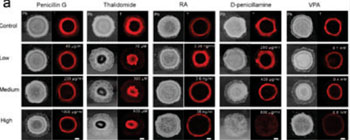Embryonic Development “In a Dish” – Recreating Two Key Processes
By LabMedica International staff writers
Posted on 21 Oct 2015
In a biotechnological advancement involving human pluripotent stem cells (h-PSCs) and geometric restriction, researchers have for the first time developed animal-free platforms to help screen for and study drugs that cause birth defects.Posted on 21 Oct 2015
A team led by Prof. Hanry Yu , principal research scientist at the Institute of Bioengineering and Nanotechnology (IBN; Singapore) of Singapore’s Agency for Science, Technology, and Research (A*STAR), has developed a cell-based model that largely recreates two key processes essential for fetal formation. The researchers not only controlled differentiation of stem cells into other cell types, but have also achieved a successful migration of these transformed cells. The latter has remained elusive to researchers until now and makes it possible to build a better embryo development model for drug testing.

Image: Phase and T immunofluorescence images of mesoendoderm patterns in different drug test groups on day 3. The morphology of the mesoendoderm pattern was significantly disrupted under teratogen (Thalidomide, RA, D-penicillamine, or VPA) treatment in a dose-dependent manner; whereas under non-teratogen (Penicillin G) treatment, the structure of the mesoendoderm pattern remained unchanged. Scale bar = 200 μm (Photo courtesy of Xing J et al. 2015 and Institute of Bioengineering and Nanotechnology, Singapore).
IBN Executive Director Prof. Jackie Y. Ying said, “Unintended exposure to compounds that can disrupt fetal development, such as thalidomide, may lead to birth defects or even miscarriage. Our breakthrough is a major step toward identifying such compounds and understanding how they affect embryonic growth, and we hope that it will eventually help to mitigate the risk of fetal exposure to these destructive agents.”
Currently, researchers rely on animal testing to assess the hazard of teratogens, but this is expensive, time-consuming, unreliable due to inter-species variability, and involves ethical concerns. To overcome these problems, researchers have focused on developing alternative tests using h-PSCs. Prof. Yu explained, “Embryonic development does not only consist of the transformation of stem cells into other cell types, such as bone, muscle, or nerve cells. It also involves the migration of these transformed cells to the right places in the body where they will develop into properly functioning organs as intended. This is why we believed it was important to develop a model encompassing both cell differentiation and migration that would give us a more complete and accurate picture of the effects of teratogens on the developing embryo.”
In the new model, the researchers confined the environment in which the embryonic stem cells transformed into other cell types, and restricted the ensuing migration of the micropatterned h-PSC colonies so that the resulting mesoendoderm cells would form a consistent circular or ring pattern. Due to this geometric restriction, it was possible for the researchers to study the effect of teratogens, which may alter the shape and even the eventual position of the mesoendoderm layer.
“A key feature of our model that would facilitate its application as a drug screening platform is the consistency with which we can generate the circular mesoendoderm layer. This provides a reliable starting point and straightforward indicator for measuring drug-induced effects,” shared Prof. Yu.
They also developed image processing and statistical algorithms to quantify and classify the teratogenic potential of different compounds. Using their micropatterned h-PSC model, they have successfully distinguished between teratogenic compounds (i.e., thalidomide) and non-teratogenic compounds (i.e., penicillin G), and could also measure dose-dependent effects, which is essential for identifying clinically relevant dose.
The team is currently looking for clinical and industrial partners to further develop and validate their technology.
The study, by Xing J et al, was published online May 2015 in the journal Scientific Reports.
Related Links:
Institute of Bioengineering and Nanotechnology













